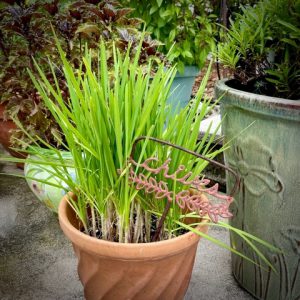Chives are a perennial member of the onion family. Onion chives (Allium schoenoprasum) and garlic chives (Allium tuberosum) are both reliable pops of green in a Keys herb garden. They produce attractive edible flowers and provide a source of garnish or green ingredient for use in many dishes. Use chives as a substitute for green onions or parsley in any dish.

Onion chives or common chives, have purple flowers in the shape of a small powder-puffs. The leaves are slender and tubular, with a mild onion flavor. Garlic chives produce flat clusters of white star-shaped flowers. The leaves are flatter and wider than those of onion chives. Garlic chives have a much stronger aroma and flavor than onion chives, but the flavor is certainly milder than garlic. During especially hot weather, the garlicky aroma of garlic chives can become overpowering, but the aroma abates with extra watering and cooler weather.

Garlic chives are sometimes confused with society garlic (Tulbaghia violacea), so named for the belief that the leaves will lend dishes a garlic flavor without causing bad breath! However, society garlic is not in the Allium genus like onion and garlic chives. Society garlic and garlic chives are very similar in appearance, with society garlic’s lavender flowers closely resembling the white flowers of garlic chives. Society garlic is generally considered appropriate for zones 8 to 10. Although you can often find it at local garden centers, it is not generally very hardy in the Keys, especially in the lower Keys.
Growing Conditions
Chives can be started from seed or divided from established plants and can be grown in pots or in the ground. The clumps will gradually expand but are easily managed in the Keys. They prefer rich, well-drained soil, but will also adapt to poor soil conditions. Chives are not picky about sunlight, although they will not thrive in full shade. At least six hours of bright indirect light is recommended. They can also tolerate full sun. In yards with constant irrigation, spreading from seed can be a problem. To reduce potential spread throughout the garden, cut, and dispose of the flowers. Chives can sometimes wilt if they have not received sufficient water, but a good soaking will perk them up in a few hours.

Chives can be harvested year-round by cutting clumps with garden scissors or shears, while allowing the leaves to regrow. The leaves and flowers are edible, though the flower stems are usually tough and are better discarded. The leaves of garlic chives will even stand up to a little cooking, whereas the more tender leaves of onion chives are best sprinkled over dishes as a garnish. Pots of either onion or garlic chives will thrive for years in the Keys if they receive regular irrigation. Garlic chives are much hardier than onion chives or society garlic if planted in beds where they might not receive regular irrigation. Once established, a clump of garlic chives in the ground is very hardy and can survive drought and salt-water flooding. Pests or diseases are rarely a problem.
Try growing some chives for a low-maintenance source of garnish or green element in your Keys herb garden.
Additional resources:
Cooking with Fresh Herbs: https://edis.ifas.ufl.edu/publication/fy1209
Written by Sharon Thomas, Master Gardener Volunteer
 0
0
